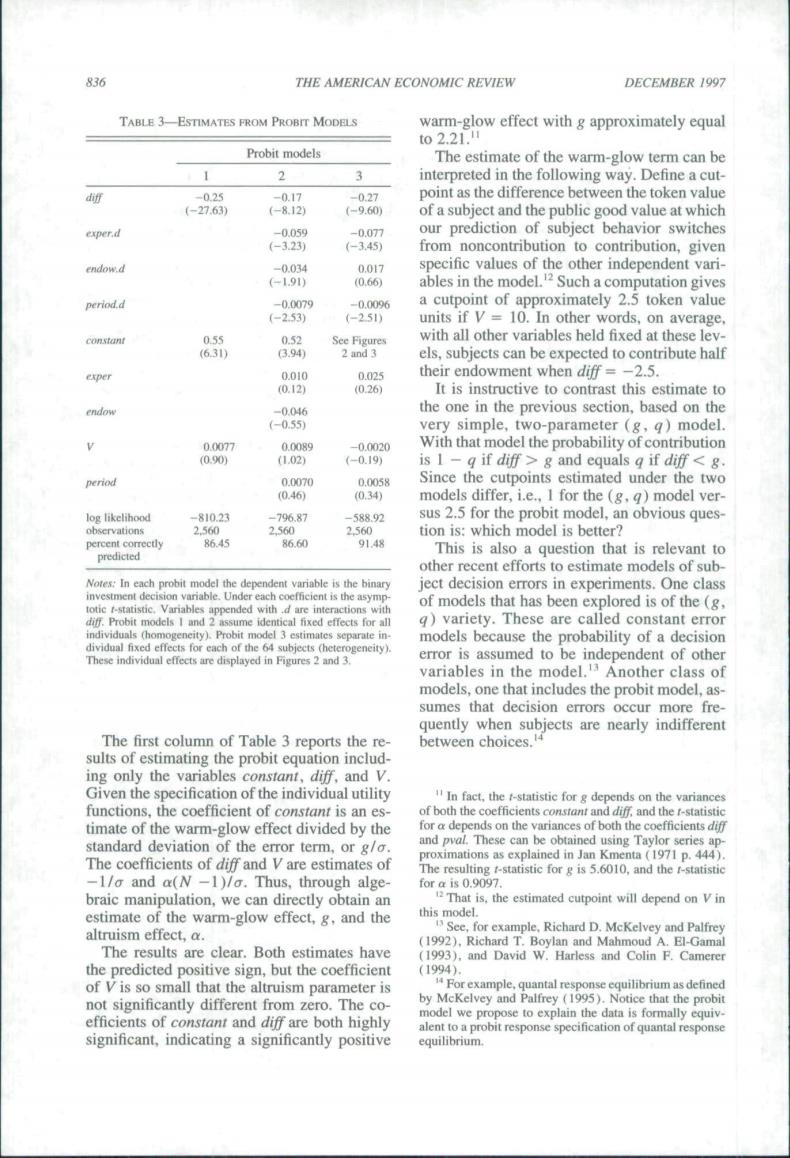正在加载图片...

836 THE AMERICAN ECONOMIC REVIEW DECEMBER 1997 TABLE 3-ESTIMATES FROM PROBIT MODELS Probit models The estimate of the warm-glow term can be 3 interpreted in the following way.Define a cut point as the d erence between the token v at whic exper.d ←9 specific values of the other independent vari ables in the model. 9 2 pproximately els,subjects can be expected to contribute half 8% their endowment when diff= -2.5 It is instructive to contrast this estimate to the the d on te 8 is I g if diff>g and equals g it diff<g Since the under h de sus 2.5 for hit ion which model s bette This is also a question that is relevant to models of mes of the cal fied effects for al q)variety.These are calied constant error models because the probability of a decision othe etween o es of bo of the e s of -1)/o.Thus,through alge a on,we nd n this m altruism effect.a. nd Palf The results are clear.Both estimates have and Colin F.Can sign,but the coefficient (1994 tal n m as define nt fr y al resp significant,indicating a significantly positive836 THE AMERICAN ECONOMIC REVIEW DECEMBER 1997 TABLE 3^ESTIMATES FROM PROBIT MODELS diff exper.d endow.d peritid.d constant exper endow V period log likelihood observaiions perceni correctly predicled 1 -0.25 (-27,63) 0.55 (6,31) 0,0077 (0,90) -810,23 2.560 86.45 Probit models 2 -0.17 (-8.12) -0.059 (-3,23) -0.034 (-1.91) -0.0079 (-2.53) 0.52 (3.94) 0.010 (0.12) -0.046 (-0,55) 0.0089 (1,02) 0.0070 (0.46) -796,87 2,560 86,60 3 -0.27 (-9,60) -0.077 (-3.45) 0.017 (0.66) -0.0096 (-2,51) See Figures 2 and 3 0.025 (0.26) -0.0020 (-0,19) 0.0058 (0,34) -588,92 2,560 91.48 Notes: In each probil model the dependeni variable is Ihe binary inveslmenl decision variable. Under each coefficient is [he asymptotic /-statistic. Variables appended with .d are interactions with diff. Probit models I and 2 assume identical fixed etfecis for all individuals (homogeneity). Probit model 3 estimates separate individual fixed effects for each of the 64 subjects (heterogeneity). These individual effects are displayed in Figures 2 and 3, The first column of Table 3 reports the results of estimating the probit equation including only the variables constant, diff, and V. Given the specification ofthe individual utility functions, the coefficient of constant is an estimate of the warm-glow effect divided by the standard deviation of the error term, or gla. The coefficients of diffdind V are estimates of -I/CT and a{N — l)/cr. Thus, through algebraic manipulation, we can directly obtain an estimate of the warm-glow effect, g, and the altruism effect, a. The results are clear. Both estimates have the predicted positive sign, but the coefficient of V is so small that the altruism parameter is not significantly different from zero. The coefficients of constant and diff are both highly significant, indicating a significantly positive warm-glow effect with g approximately equal to 2.21." The estimate of the warm-glow term can be interpreted in the following way. Define a cutpoint as the difference between the token value of a subject and the public good value at which our prediction of subject behavior switches from noncontribution to contribution, given specific values of the other independent variables in the model.'^ Such a computation gives a cutpoint of approximately 2,5 token value units if V = 10. In other words, on average, with all other variables held fixed at these levels, subjects can be expected to contribute half their endowment when diff = —2,5. It is instructive to contrast this estimate to the one in the previous section, based on the very simple, two-parameter (g, q) model. With that model the probability of contribution is I — g if diff > g and equals q if diff < g. Since the cutpoints estimated under the two models differ, i,e., 1 for the (g, q) model versus 2,5 for the probit model, an obvious question is: which model is better? This is also a question that is relevant to other recent efforts to estimate models of subject decision errors in experiments. One class of models that has been explored is of the (g, q) variety. These are called constant error models because the probability of a decision error is assumed to be independent of other variables in the model.'^ Another class of models, one that includes the probit model, assumes that decision errors occur more frequently when subjects are nearly indifferent between choices.''* '' In fact, the /-statistic for g depends on the variances of both the coefficients constant and diff. and the /-statistic for a depends on the variances of both the coefficients diff and pval. These can be obtained using Taylor series approximations as explained in Jan Kmenta (1971 p. 444). The resulting r-st£Uistic for g is 5.6010, and Che /-statistic for a is 0.9097, '- That is, the estimated cutpoint will depend on V in this model. " See, for example, Richard D, McKelvey and Palfrey (1992), Richard T, Boylan and Mahmoud A. El-Gamal (1993), and David W. Harless and Colin F, Camerer (1994), '^ For example, quantal response equilibrium as defined by McKelvey and Palfrey (1995). Notice ihat the probit model we propose to explain the data is formally equivalent to a probit response specification of quanta! response equilibrium